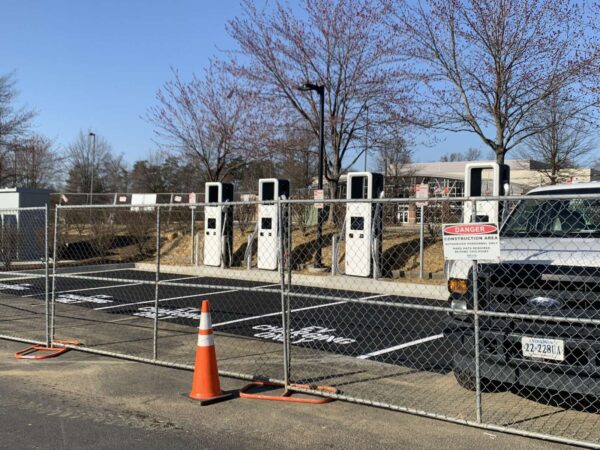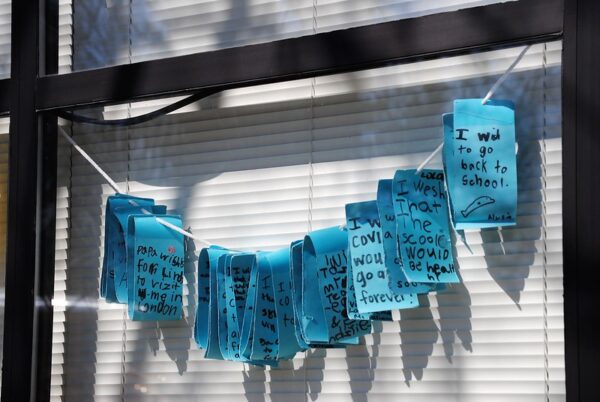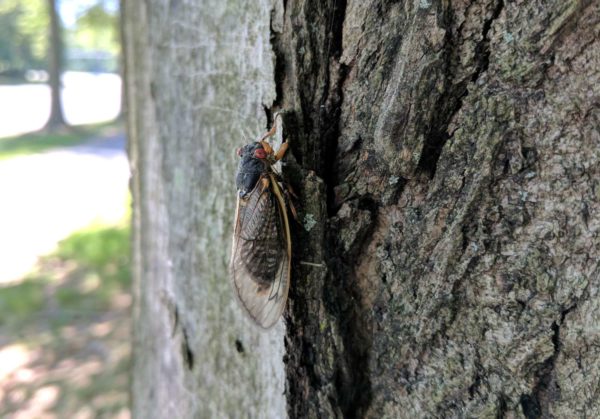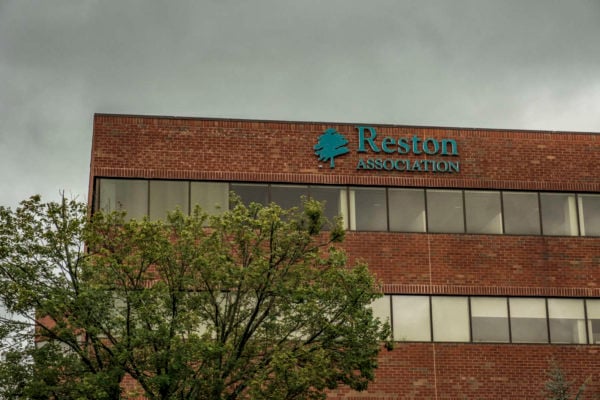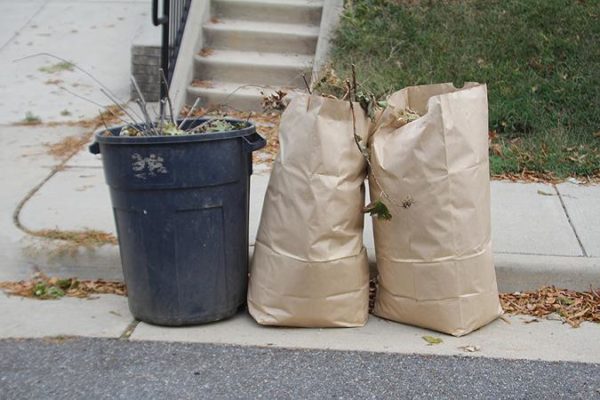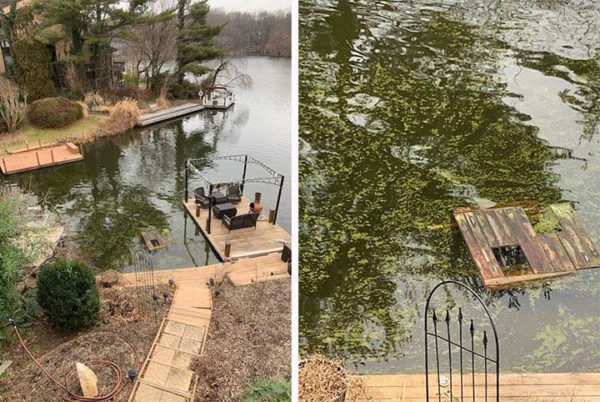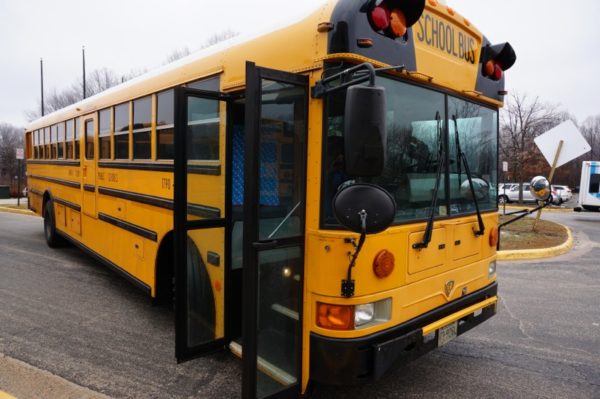 This is an opinion column by Del. Ken Plum (D), who represents Reston in Virginia’s House of Delegates. It does not reflect the opinion of Reston Now.
This is an opinion column by Del. Ken Plum (D), who represents Reston in Virginia’s House of Delegates. It does not reflect the opinion of Reston Now.
The highlight of last week along with Earth Day was the announcement by President Joe Biden that the United States is returning to the Paris Climate Agreement. The Agreement that was adopted by nearly 200 nations of the world came into being in 2016. President Barack Obama led the United States in joining the Agreement that united the world’s nations for the first time in a single understanding on global warming and cutting greenhouse gas emissions.
The only other example of something like this agreement previously was the Montreal Protocol in which 197 countries agreed in 1987 to ban chlorofluorocarbons (CFC). Scientists had discovered that CFC was causing a hole in the ozone layer which if not stopped would lead to disastrous health results. All nations banned CFC as a result. The United States estimates that because of the ban by the year 2065 more than 6.3 million skin cancer deaths would have been avoided and between 1985 and the year 2100 Americans avoiding suffering from cataracts would number 22 million.
With the Montreal Protocol the leaders of the world responded to scientific findings, prevented a huge amount of human suffering, and saved trillions of dollars in healthcare costs. On the subject of climate change and global warming there are those who want to continue to debate scientific findings and ignore the evidence that is becoming even more apparent that the earth is heating up and the consequences are going to be devastating if action is not taken right away.
The Paris Climate Agreement commits nations of the world to take action to keep global temperature well below the pre-industrial level of 2.0C or 3.6F and endeavor to limit temperature rise to 1.5C. The Agreement limits the amount of greenhouse gases emitted by human activity to the same levels that trees, soil and water can naturally absorb. Each country sets its own emission-reduction targets that are reviewed every five years. The Agreement has richer nations helping poorer countries with financing to switch to renewable energy.
While the United States left the Agreement for a short time under the previous president the announcement by President Biden restores the United States to its rightful role of being a leader in ending climate change. Many states and cities had pledged to seek these goals even when the country for a short time seemed not willing to. After all the United States is the largest contributor to greenhouse gases exceeded only by China. Beyond re-joining the Agreement, the President is committing the United States to more aggressive actions to cut emissions by 2030 rather than 2050 that scientists now say is necessary if we are to avoid the worst effects of climate change.
Just as nations came together to rid the world of CFC and prevent major health horrors, I believe that nations can come together to provide responsible leadership and actions to stop climate change. It will cost money to do so, but the savings to the planet will be inestimable. We will end fossil fuel use, control carbon release, and adopt more alternative and resilient ways of living and doing things. Our country can and will be a leader in these planet-saving changes!
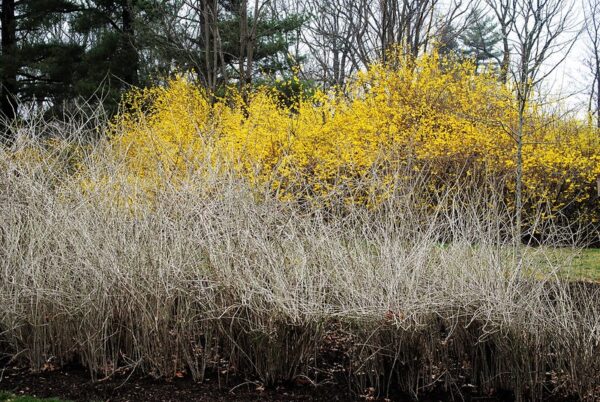
D.C. Region Backs Statehood for Capital — The Metropolitan Washington Council of Governments Board of Directors, which consists of elected officials from D.C. area governments, unanimously passed a resolution yesterday (Wednesday) urging Congress to “establish the state of Washington, D.C. without delay.” Fairfax County was represented on a task force dedicated to the issue of D.C. statehood by Lee District Supervisor Rodney Lusk. [MWCOG]
NoVA to Expand COVID-19 Vaccine Appointments — Virginia Vaccine Program Coordinator Dr. Danny Avula says that COVID-19 vaccine appointments will become more readily available in Northern Virginia “in the next couple of weeks.” Loudoun County and the City of Alexandria have already entered Phase 2, but appointments may initially become harder to schedule when localities like Fairfax County expand eligibility. [WTOP]
Bilingual Election Officers Needed for Primary — The Fairfax County Office of Elections is looking for individuals who speak English and Vietnamese or Korean to serve as election officers for the Democratic primary on June 8. The application deadline is on April 28. [Fairfax County Office of Elections/Twitter]
Reston Association Thanks Trash Clean-up Volunteers — “Many thanks to all the volunteers who took part in last Saturday’s 33rd Annual Potomac River Watershed Cleanup coordinated by the Alice Ferguson Foundation. A total of 93 volunteers collected 115 bags of trash.” [RA/Twitter]
Comscore Partners with Atlas Obscura — The Reston-based media analytics company Comscore announced an agreement yesterday with the online guidebook and travel company Atlas Obscura. The deal gives Atlas Obscura access to Comscore’s data platform so that it can “better understand audience behavior and media consumption across desktop and mobile devices.” [PR Newswire/WFMZ-TV]
Photo via vantagehill/Flickr
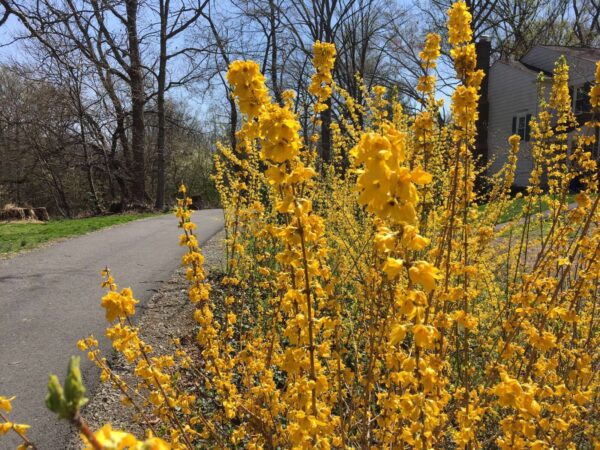
Metro Board Debates Lowering Fares — “During the transit authority’s bi-monthly board meeting Thursday, four board members voiced support for a flurry of proposals that would simplify or reduce rail fees, including lower fares and eliminating rush hour peak pricing.” [DCist]
Paycheck Protection Program Deadline Extended — The deadline for small businesses to apply for forgivable loans from the federal COVID-19 relief program has been extended to May 31. The new PPP application period includes a 14-day window exclusively open to businesses and nonprofits with fewer than 20 employees. [Fairfax County Economic Development Authority]
Virginia to Overhaul Police Shooting Investigations — “Virginia’s attorney general and the state’s NAACP announced Wednesday that they are launching a collaborative effort to bring more transparency, impartiality and public confidence to the way police shootings are investigated across the commonwealth.” [The Washington Post]
Hunter Mill Supervisor to Assist with Potomac River Cleanup — “Help clean up our beautiful communities! This Saturday, April 10 is the Potomac River Watershed Cleanup. I’ll be participating in events in Reston and the weather looks good, so please consider joining us!” [Supervisor Walter Alcorn/Twitter]
Federal Assistance Available to Shuttered Venues — The Small Business Association’s Shuttered Venue Operators Grant program is now accepting applicants seeking assistance with payroll, rent, and other expenses. Supported by $16 billion from the American Rescue Plan Act, the program is open to live venue operators, promoters, theatrical producers, live performing arts organizations, museums, zoos, aquariums and theaters. [Fairfax County Government]
RCC Unveils Plans to Celebrate Earth Day — Reston Community Center’s 2021 Earth Day activities will include a photo scavenger hunt, play-dough making, storytelling, and supplies for a home herb garden. Advance registration and face masks are required for the Green Reston program on April 24. [Patch]
Photo via Mary Dominiak/Twitter
 This is an opinion column by Del. Ken Plum (D), who represents Reston in Virginia’s House of Delegates. It does not reflect the opinion of Reston Now.
This is an opinion column by Del. Ken Plum (D), who represents Reston in Virginia’s House of Delegates. It does not reflect the opinion of Reston Now.
As a child of frugal parents who grew up during the Great Depression, I was always taught as long as I did not waste food or material things that I would never be without. “Waste not, want not” was an oft-heard slogan around our house. I carried my lunch to school in a brown paper bag that was recycled from our grocery store purchases, and my peanut butter and jelly sandwich was wrapped in wax paper. After lunch I would fold up the wax paper inside the bag and carry it home in my back pocket for use the next day. I could generally go an entire week without the need for another bag or more wax paper.
Needless to say, I feel a high level of discomfort with our current throw-away society. Not only do we consume ever-increasing levels of natural resources, but we create mountains of waste and the resulting degradation of our environment. Nowhere is the problem more evident than with plastic products. My paper bag and wax paper have been replaced with plastic bags for chips, a plastic container for fruit or dessert, a plastic sandwich wrapper and a drink in a plastic bottle. The manufacturer’s ability to find new uses and the public’s willingness to accept them seem unlimited
A two-year research project by the Pew Charitable Trusts and SYSTEMIQ, Ltd., a London-based environmental think tank, estimates that by 2040 the amount of plastic trash that flows into the oceans every year will triple to 29 million metric tons. Its report “Breaking the Plastic Wave” lists challenging actions that need to be taken to reverse this dangerous threat to our environment. (www.pewtrusts.org, July 2020). The Report was peer reviewed and presented in the journal Science (science.sciencemag.org, July 2020).
The report calls for a wholesale remaking of the global plastics industry by shifting to a circular economy that reuses and recycles plastics. It discusses ten critical findings “showing that a path forward to a low plastic pollution future already exists–now we have to make the choice to walk this path.” The Virginia General Assembly took two steps on the pathway to reduce plastic pollution.
A bill on which I was a co-patron passed and which the Governor has now signed into law prohibits the use of expanded polystyrene food containers, the white foam containers that break into endless number of pieces and litter our beaches and roadsides. The legislature also passed a bill designating advanced recycling as a manufacturing process that must follow all federal and state environmental regulations and laws and a budget amendment I introduced to require the Department of Environmental Quality to monitor the newly-emerging industry. Governor Northam recently signed a new executive order that will decrease plastic pollution and reduce the amount of solid waste going to landfills by phasing out single-use plastics at state agencies.
Clearly the General Assembly must take more aggressive actions in the future to reduce the use of plastics, provide for their reuse or recycling, and recognize that multiple strategies must be taken if the challenges that the Pew study identified are to be addressed. Citizens can join in taking voluntary actions to make choices in the marketplace of alternatives to plastics. Returning to a paper lunch bag or reusable container is a good idea, but the reuse of wax paper is not recommended!
New electric vehicle charging stations are coming to Target in Reston this summer.
While the stations have been installed, they won’t go live until the summer. Four 150 kilowatt-hour chargers are planned at Target, which is located at 12197 Sunset Hills Road.
The stations are powered by Electrify America, a Reston-based company that promotes zero-emission vehicle adoption through an a fast and convenient charging network across the country.
The company, which was founded in 2016, currently does not have plans for additional stations in Reston and Herndon, a company spokesperson told Reston Now. But other locations are planned in Northern Virginia.
So far, the company has built more than 570 charging stations with around 2,500 individual chargers. Last year, Electrify America also completed two cross-country routes.
Roughly 800 total stations with about 3,500 chargers that are specifically designed for quick charging are planned by the end of this year.
The expansion at Target is part of a nationwide push to expand electric vehicle charging option. In 2018, Target announced that it plans to add the stations to 600 parking spaces at more than 100 sites across more than 20 states.
“Accelerating our efforts to install new charging stations at Target stores across the country is one way we’re building on our commitment to investing in solutions that leave our communities better for future families,” said John Leisen, vice president of property management at Target.
Photo via Matt Bianco
County Seeks Help with Vaccinations — The county’s health department is hiring roughly 250 vaccinators. Interested candidates should have experience vaccinating and hold a current license or multistate licensure privilege. [Fairfax County Government]
Reston Association Election Underway — Voting ends on April 2 at 5 p.m. Four candidates are running for two at-large seats and one person is vying for the South Lakes District seat. A 10 percent quorum is required for the results of the election to be considered valid. [Reston Today]
Local Organizations Receive Homeless Reduction Grants — Twelve projects in the Northern Virginia area received a total of $2.1 million in state grants from the Virginia Housing Trust Fund. Reston-based nonprofit organization Cornerstones received $100,000 to fund housing stabilization case management. [Patch]
State Bans Single-Use Styrofoam — Gov. Ralph Northam has signed a bill into law that bans the use of Styrofoam cups and food takeout containers. Food chains with 20 or more locations cannot package or dispense food in the containers beginning July 2023. [Patch]
Photo via vantagehill/Flickr
The cicadas are coming.
17 years after their last appearance, swarms of cicadas known collectively as periodical cicada Brood X are preparing to stage a sequel this spring, with the D.C. area as the epicenter of a natural phenomenon that will encompass 15 states across the eastern and midwestern U.S.
Tammy Schwab, a naturalist and education and outreach manager for the Fairfax County Park Authority, says the insects are expected to emerge in the county around the middle of May, when the ground temperature reaches about 64 degrees Fahrenheit.
“Cicadas are special because of their extremely long life cycle,” Schwab told Tysons Reporter by email. “Cicadas spend 2-17 years as a larva underground feeding on the roots of trees. Most other insects have much shorter life spans.”
According to the National Wildlife Federation, adult periodical cicadas are black with orange underneath. They are just over an inch in length and boast clear, “membranous,” black-veined wings that span three inches across.
These cicadas are different from annual cicadas, which live underground for two to five years before emerging as adults, typically between May and September. Because their life cycles aren’t as closely synchronized as periodical cicadas, some annual cicadas appear every year.
Fairfax County last saw Brood X — one of 15 periodical cicada broods in the U.S. — at the scale anticipated this spring in 2004, but a handful of the insects were spotted locally in 2017.
“As part of the cicada survival strategy some of each brood can emerge between 1 and 4 years early in case some catastrophe were to destroy all the cicadas in a given emergence,” Schwab explained.
They're coming! This is the year of the 17-year cicada in our area. There will be trillions of them in early summer. They are harmless. They are loud. They are high in protein, if you're into that. They don't social distance. It's a phenomenon of nature to be enjoyed. Can't wait! pic.twitter.com/WR5qWCXq3m
— Fairfax County Parks (@fairfaxparks) March 4, 2021
In comparison, Schwab says “millions” of cicadas could blanket the D.C. region this year, though the numbers could vary across different areas depending on how much land development has occurred over the past 17 years.
Both adult and larval cicadas depend on trees for food, so they tend to be more prevalent in forested areas. However, people in more developed residential neighborhoods might notice them sooner, since the ground warms more quickly in open spaces than in the woods, according to Schwab.
She says the loss of tree cover to development “will definitely decrease populations,” but reforestation prior to an emergence could result in an increase. Fairfax County had stream bank stabilization projects at Snakeden Branch in Reston, Difficult Run in Oakton, Accotink Creek, and Cinnamon Creek in the Wolf Trap area in 2003, the year before Brood X’s last emergence.
“It would be very interesting to see if these project areas had any effect on the population,” Schwab said.
While the appearance of millions of loud, winged insects may sound alarming, cicadas are harmless for humans. The most notable impact will be on newly planted trees, which can be damaged by cicada egg laying.
Schwab advises residents to wait until the fall before planting new trees or utilize insect netting to protect their branches.
She also says people should watch what their pets are eating.
“A few are not likely to hurt pets but too many could cause digestive issues,” Schwab said. “They are edible by people if you’re are brave enough to try it.”
Photo courtesy Fairfax County Park Authority
Reston Association (RA) is looking at potentially going a bit greener.
The RA Board of Directors unanimously approved a pair of motions brought to it during its Feb. 25 meeting by Director Tom Mulkerin that are focused on electric vehicles and subsequent charging stations.
The first motion directs RA staff to use the next 120 days to study the feasibility of replacing the association’s current fleet of fossil-fueled vehicles over the next 10 years. The staff is also directed to study the potential installation of a Level 3 charging station at the Central Services Facility to recharge its electric fleet.
RA staff is charged with addressing four primary questions with its study. The first portion of the stud will look at the comparative costs of acquisition, operation, maintenance and repair of electric vehicles versus the current fleet that uses fossil fuels.
The second part is an evaluation of the estimated financial and operational impact on the Central Service Facility and finding a conversion timeline for the fleet. It also includes diagnosing the skills and equipment required for the maintenance of both the electric vehicles and existing fleet.
The third item is finding the expected cost of the installation, operation, maintenance and repair of charging stations and a projected useful lifespan compared to the cost of fueling the existing fleet.
The board also directed staff to study the possibility of installing electric vehicle charging stations at one or more RA facilities over the next three months.
The scope of the second study includes reviewing the specific charging station types for recommendation, the expected volume of use, the anticipated costs to users of the stations and the general installation, operation, maintenance and repair costs of stations.
Staff will also examine if the stations would be compatible with RA sites.
Finally, the study would examine if the overall costs of the program would generate a meaningful profit and when that profit would materialize.
“I think we should look at the opportunity just to say, ‘Is it worthwhile?,'” Mulkerin said. “Then if it’s not, we can say to our membership, ‘We looked at it. It wasn’t worth it to do it,’ or agree.”
Trash collectors in Fairfax County will not pick up leaves, grass clippings, and other yard waste stored in plastic bags when the collection season begins on Monday (Mar. 1).
After holding a public hearing, the Fairfax County Board of Supervisors voted 9-1 on Tuesday (Feb. 23) to officially prohibit the use of plastic bags for yard waste by amending its Solid Waste Management Ordinance, a move that supporters say is necessary to reduce pollution and make the county more environmentally friendly.
“To reverse climate catastrophe, each of us must make many small and large steps,” Faith Alliance for Climate SolutionsBoard Chair Eric Goplerud said when testifying at the public hearing. “Banning plastic bags to contain yard waste is a step that the Board of Supervisors can take to lead our community to care for our common home, the Earth.”
Fairfax County began transitioning away from using plastic bags for yard waste last year, encouraging residents to use compostable paper bags or reusable containers instead.
In an update to the board’s environmental committee on Oct. 27, county staff reported that about 51% of homes surveyed during the 2020 yard waste season were still utilizing plastic bags, but Fairfax County Director of Engineering and Environmental Compliance Eric Forbes says he is “hopeful and confident” that the bags can be eliminated after the past year of education and outreach.
Now that the ban has been approved, the county’s solid waste management program is encouraging private trash and recycling collection companies to notify their customers that waste in plastic bags will no longer be collected.
“We do not anticipate a hundred percent success rate in the beginning, but we will continue our outreach and collaboration with industry to help our community to reach compliance with the new requirements,” Forbes said.
Forbes acknowledged that compostable paper bags are slightly more expensive to buy than plastic bags. County staff found that paper bags designed to carry yard waste cost about 50 cents per bag, whereas plastic bags cost around 30 cents.
Yet, the overall cost of utilizing plastic may be greater, since the material is difficult to extract and can damage equipment during the composting process, pushing up costs for collectors and, by extension, customers, Board of Supervisors Chairman Jeff McKay says.
While paper bags are preferable to plastic, Forbes noted that residents can avoid the costs of yard waste removal altogether by managing it on-site with backyard composting or allowing grass clippings to decompose on their lawn, a practice known as grasscycling.
McKay says he got 75 emails on the proposed ban, with an even split between supporters and opponents, but he believes it is time for Fairfax County to join the rest of the D.C. region, where some jurisdictions have required paper bags or reusable containers for more than a decade.
“We ultimately just have to decide whether we think this is a good idea or not,” McKay said. “…I think clearly, based on the testimony that we’ve heard today, based on where everyone around the region is, and frankly, based on where the science is, this is something that we must do now to help with our environmental challenges.”
Photo via Fairfax County Government
 This is an opinion column by Del. Ken Plum (D), who represents Reston in Virginia’s House of Delegates. It does not reflect the opinion of Reston Now.
This is an opinion column by Del. Ken Plum (D), who represents Reston in Virginia’s House of Delegates. It does not reflect the opinion of Reston Now.
In 1998 I chaired a task force of business and community leaders to collectively document what Northern Virginia needed to do to be an “EV Ready Community.” Our work was part of a national effort involving ten communities under the sponsorship of the U.S. Department of Energy and the Electric Vehicle Association of the Americas to prepare for the introduction of electric vehicles. Our inch-thick report was very comprehensive in detailing the infrastructure needed in charging stations, building and roadways, and other changes that electric vehicles would require.
We were ahead of our time. Within about a year of our report the first commercial electric car, EV1, was no longer available and other manufacturers were not offering electric vehicles. Move ahead less than two decades and electric vehicles are becoming commonplace in many areas. I even own one, and on trips in my community I always see more than one.
What happened in the meantime is a greater awareness of our transportation system’s contribution to greenhouse gases and pollution. In the United States alone in 2017, the transportation sector accounted for 29% of the nation’s total emissions of 6.4 billion metric tons of carbon dioxide equivalent, or CO2e (the CO2 equivalent of an individual greenhouse gas). Driven largely by the transportation sector’s emissions of fossil fuels, concentrations of CO2 in the atmosphere have risen steadily since the early 1980s, according to the U.S. Energy Information Administration. Interestingly, when there is a recession there is a corresponding dip in emissions.
In addition to the increased awareness of the adverse effects of our conventional transportation on the environment, there has been an increase in the number of entrepreneurs who are willing to make major investments in developing electric cars and other vehicles and increased competition from abroad. A Super Bowl commercial sponsored by General Motors lamented the fact that in Norway 54 percent of the new cars sold are EVs. The president of General Motors announced recently that the company would phase out gasoline vehicles and sell only electric passenger cars and trucks by 2035. Press accounts are that Ford Motor Company is making major investments in electric vehicles and VW that is about to move its US headquarters to Reston will be investing $37 billion in electric vehicles.
In the General Assembly I am a co-patron along with the patron Delegate Lamont Bagby of HB1965 that directs the State Air Pollution Control Board to implement a low-emissions and zero-emissions vehicle program for motor vehicles with a model year of 2025 and later. The legislation will help resolve the problem of consumers in Virginia who want to buy an electric vehicle but must go out of the state to do so. Along with a rebate program the vehicles will become more affordable for persons of limited income. There have been major investments in charging stations throughout the state enabling travel without the fear of running out of juice. You may have noticed the Wawa in Vienna that sells electric charging only but no gas.
I need to review more carefully that report of two decades ago to make sure we are ready for EVs. Ready or not, here they come!
Updated on Feb. 1 to correct information on the project phase and jurisdiction receiving funding
Despite being approved more than two years ago, the construction phase of the restoration of Sugarland Run (South) Stream still hasn’t begun.
The $1.2 million project remains in the design phase, according to the Town of Herndon’s deputy Director of Public Works John Irish, though it’s expected to be completed by May.
The project will improve stormwater systems, stabilize erosion along streambanks, prevent flooding, and ensure the stream meets requirements for Chesapeake Bay Total Maximum Daily Load, first established in 2010. It will do this by planting vegetation, in-stream structure placement, and installing brush mattress.
The conditions along the stream banks and stream valley have been deteriorating in recent years.
The project will also restore a portion of the stream that flows near the Washington & Old Dominion Trail crossing.
The town received $200,000 from Fairfax County for the design work, which includes the geomorphic assessment, surveying, and public outreach meetings.
Irish writes to Reston Now in an email that this phase is “approximately 95% completed.”
In all, the design phase will end up taking up nearly three years. This is due to Herndon being asked by the county to apply for and, then, waiting for a state grant.
A stream condition assessment and negotiation of a fee that met budgetary guidelines also took time, writes Irish.
All in all, design work didn’t start until February 2020.
After designs are completed in May, they will be sent to the county with a request for one million dollars for construction. Once those funds are received, Herndon will advertise for construction bids.
Despite seemingly a long way to go in the process, Irish says construction is still expected to start this summer and completed within six months of the awarded contractor being given the go-ahead.
That means the project could be completed by the end of 2021 or early 2022.
The initial funding agreement did estimate the project could take up to four years, so the project theoretically could still be completed on time if not early.
However, a spokesperson for Fairfax County Department of Public Works and Environmental Services tells Reston Now that this particular project is “lower priority” as part of their full Sugarland Run Watershed Management Plan, which was first adopted in 2010.
It remains unclear how this assessment will impact the expected providing of one million dollars to the Town of Herndon for construction and completion of Sugarland Run Stream restoration later this year.
A rare winter algae bloom that has both toxic and non-toxic forms has formed over Lake Thoreau.
Reston Association is advising caution after the bloom — known as Aphanizomenon flos-aquae – took over parts of the lake. The bloom is toxic if humans ingest it but dogs can become ill after ingesting or coming in contact with the algae.
The association has no immediate plans to treat the lake until water temperatures are in the upper 50s.
In the latest budget cycle, RA’s Board of Directors significantly increased its funding allotment by 86 percent for lake management and water treatment after major blooms — caused partially by ineffective or delayed water treatment — consumed Lake Thoreau over the summer.
Monthly treatment is expected to begin in the spring as part of RA’s new lake management strategy.
But winter blooms are more uncommon in Reston.
In a statement released today, RA noted that Reston typically does not have algae blooms in the winter because of colder temperatures. Water temperatures have hovered in the upper 30s and lakes have not completely frozen this season.
RA’s spokesman Mike Leone said that the organization has not yet determined the toxicity of the current bloom. He noted that certain species of cyanobacteria are referred to as toxic because they can harm people, pets and wildlife.
‘The current algae bloom has the potential to be toxic but it does not mean that it is toxic all the time. Given the potential though, RA encourages individuals and their pets to avoid contact with water where they see visible algae just to be safe,’ he wrote in a statement to Reston Now.
RA staff found that areas where the algae bloom was before have already been reduced.
Photo via RA
Fairfax County Public Schools is getting its first electric school bus today as part of a statewide initiative led by Dominion Energy.
The bus is expected to arrive at the Stonecroft Transportation Center in Chantilly. It is the first of eight vehicles that FCPS will receive from Dominion in an initial deployment of 50 buses throughout Virginia.
FCPS says it anticipates getting the remaining seven buses by the end of January.
Made by Thomas Built Buses, the new vehicles will join Fairfax County’s fleet of approximately 1,625 diesel-fueled school buses, one of the largest in the country.
“Electric school buses in FCPS will benefit not only the school division and its community, but the entire national capital area,” FCPS says. “…They will help reduce carbon emissions, serve as a resource for national emergency planning efforts, and provide stability and capacity to the grid with meeting increasing energy demands.”
While electric buses are more expensive to purchase than diesel ones, they are cheaper to maintain and operate. FCPS is covering the difference in the initial cost with a grant from Dominion Energy, which also funded the installation of electric charging infrastructure at the Stonecroft facility and is responsible for maintaining the equipment.
FCPS says training for bus drivers, maintenance technicians, and other staff will start once the first bus arrives. The vehicles will undergo testing before being assigned to routes in early to mid-April, though whether there will be any students for them to transport at that time remains to be seen.
The arrival of Fairfax County’s first electric bus is a welcome step forward for community members and public officials who have been advocating for a transition to electric vehicles, citing health and financial benefits as well as environmental ones.
One of the most prominent advocates for electric school buses has been the Fairfax County branch of the national climate advocacy group Mothers Out Front, which launched a campaign in 2019 calling on FCPS to commit to converting its entire fleet to electric power by 2024.
“We are so excited for Fairfax to get its electric school buses on the ground and running,” Mothers Out Front Fairfax co-leader Barbara Monacella said in a statement. “…Every electric school bus we add to our fleet reduces the air pollution from diesel that harms our kids’ health, and brings us closer to our goal of converting every bus in order to reduce emissions and fight climate change.”
The community advocacy group has teamed up again with Del. Mark Keam (D-35th) on legislation that would create a state fund for school districts to purchase electric buses, a move aimed at addressing concerns about the amount of control Dominion has over the current initiative.
Last year, lawmakers opted to pursue the utility company’s pilot program instead, but Monacella says Keam will reintroduce his bill when the Virginia General Assembly convenes for its 2021 session on Wednesday (Jan. 13).
“We applaud the buses Fairfax has added, and we hope to add more through the state grant fund in the future,” Monacella said. “With every electric bus we add, we move the needle for our kids’ health and their future in the face of climate change.”
The Reston Association’s (RA) Board of Directors listened to a presentation about its surrounding environment as part of the Reston Annual State of the Environment Report (RASER) on Thursday, Dec. 17.
Doug Britt, a Virginia Master Naturalist and chair of RA’s Environmental Advisory Committee, presented the RASER study update to the board and RA’s members. The update has 18 authors and coauthors that include members of RA’s environmental advisory committee and outside individuals.
The update conforms to RASER’s five objectives listed on RA’s website:
- Summarize existing quantitative environmental data for the Reston community in one publicly accessible document.
- Establish an environmental baseline that can be reassessed annually to facilitate the identification of environmental trends and to evaluate the efficacy of environmental improvement and conservation programs and initiatives.
- Provide relevant and timely environmental information that can help RA and its board of directors in shaping future policy and programs.
- Help educate and inform Reston residents and other interested parties about Reston’s environmental health.
- Create a living document that can be revised and expanded as deemed appropriate to meet future environmental challenges and information needs.
This latest RASER update focused on 21 natural resources or environmental topics. Each topic was color-coded green (good), yellow (fair), red (poor), or black (undetermined) to indicate its overall condition.
The following attributes received a green status: air quality, drinking water, wastewater treatment, hazardous materials and toxic waste, and environmental education and outreach.
Fair attributes include: streams, lakes and ponds, urban forests, meadows, landscaping and urban agriculture, birds, wildlife management issues, and light pollution.
Poor attributes include storm water management and solid waste management.
Undetermined attributes include: wetlands, mammals, reptiles and amphibians, invertebrates, noise pollution, and climate change.
Britt described storm water management as “perhaps the biggest existing problem” in Reston. He estimates that the issue dates back to the lack of strict county regulations when Reston was expanding in the 1960s and 1970s.
Single-use plastics are one of the primary concerns that resulted in solid waste management receiving a poor rating. Britt added that litter created by personal protection equipment and food carryout materials have been a unique issue in 2020.
Britt said the RASER group would come back at another board meeting to present a standalone report on energy efficiency. He said there is a plan to include the category in the 2020 RASER update, but the subject was so “complex to take on” that the group decided to separate the subject from this update.
The RASER project team will return to RA’s board in either January or February to present a combined list of recommendations for RA and a report card on how attributes have been addressed.
The board approved to accept the report as it was presented Thursday. Now that the nearly 200-page report has been accepted by the board, the full copy of it will be available to the public on RA’s website under the environmental page.
“This group has been the most amazing group of volunteers,” board member Sarah Selvaraj-D’Souza said of the RASER project team.
“It’s been a pleasure to watch them work. Their dedication is just unbelievable.”
RASER was first published in July 2017 and updated in 2018. It is now updated and published biennially while the RASER project team publishes a report card and recommendations annually.
Photo via Reston Association/Facebook
The Reston Annual State of the Environment Report (RASER) will be presented to the Reston Association (RA) during its regular board meeting on Thursday, Dec. 17.
Doug Britt, a Virginia Master Naturalist and chair of RA’s Environmental Advisory Committee, will present the study update and the state of Reston’s environment to the RA board and members.
The comprehensive study is roughly 200 pages long and comes on the heels of more than 1,000 volunteer hours to update the report on its bi-annual basis. The report covers 21 different environmental attributes of the community that includes natural resource maintenance, health of wildlife, air quality, and environmental education and outreach.
The study is co-led and co-edited by Robin Duska, a former environmental advisory committee member, and includes the work of 18 authors and co-authors. The authors include members of the environmental advisory committee and outside individuals with specialized expertise.
“For each topic that we address, we collect the most reliable information that we can about the subject here in Reston,” Britt said.
“When we don’t have enough Reston data, we’ll look at county data, regional data and state data. And then we organize each topic around a background that defines the environmental attribute and then an existing edition section, and then a conclusion section.”
RASER’s five objectives are listed on RA’s website as the following:
Summarize existing quantitative environmental data for the Reston community in one publicly accessible document.
Establish an environmental baseline that can be re-assessed annually to facilitate the identification of environmental trends and to evaluate the efficacy of environmental improvement and conservation programs and initiatives.
Provide relevant and timely environmental information that can help RA and its board of directors in shaping future policy and programs.
Help educate and inform Reston residents and other interested parties about Reston’s environmental health.
Create a living document that can be revised and expanded as deemed appropriate to meet future environmental challenges and information needs.
The report was expanded this year to include two attributes: solid waste management and climate change. It also utilizes a larger amount of visual exhibits with 182 photos, tables or charts.
To make the report more user-friendly, most references will include hyperlinks to more information on subjects or view the original sources.
Each attribute in the report is given a subjective assessment of its condition. Each assessment is given a traffic light rating of green (good), yellow (fair), or red (poor), and unlit icons signify that more information is needed on the topic. In the 2020 study, five subjects were given green, eight yellow, two red and six are unlit.
“Every time we update this report, we find more and more information that helps us understand the nature of the topic,” Britt said.
“I think we have come a long way from 2017 to where we are now in our understanding and documenting the status of the attributes and how they’re changing with time, if they are.”
Britt clarified that there were not “any major changes in the subjective quality of the attribute from the previous report.”
Portions of the study will include possible changes RA can create an initiative for, while individual residents can address other items. However, many potential changes will come from outside the community at the county or state level.
Various items will be highlighted for discussion through the study. Among those is a fact Britt said came out of a new chapter of the study on water management wherein it was found that residents in Reston use 19 million plastic bags per year and less than 1% of those are ever recycled.
Over the years, Britt has witnessed efforts being made in Reston to mitigate existing issues. Among those efforts have been Reston utilizing stream mitigation banks to restore over half of the area’s perennial streams, and RA adopting a program to secure lakefront areas with biologs to prevent erosion.
Also, based on a recommendation in RASER, RA applied for and received a grant to put on a local workshop last year on what individual homeowners can do to capture and retain storm water runoff on their properties.
Britt expressed that one of his primary concerns with this study is to get board approval for public distribution to allow for more exposure to it for a broader range of stakeholder in the community.
The RASER presentation next week will be separate from recommendations and a report card for protecting or enhancing individual attributes. Britt is planning to present those items apart from the full report in the RA board meeting in January or February.
Photo by Ruth Seviers


